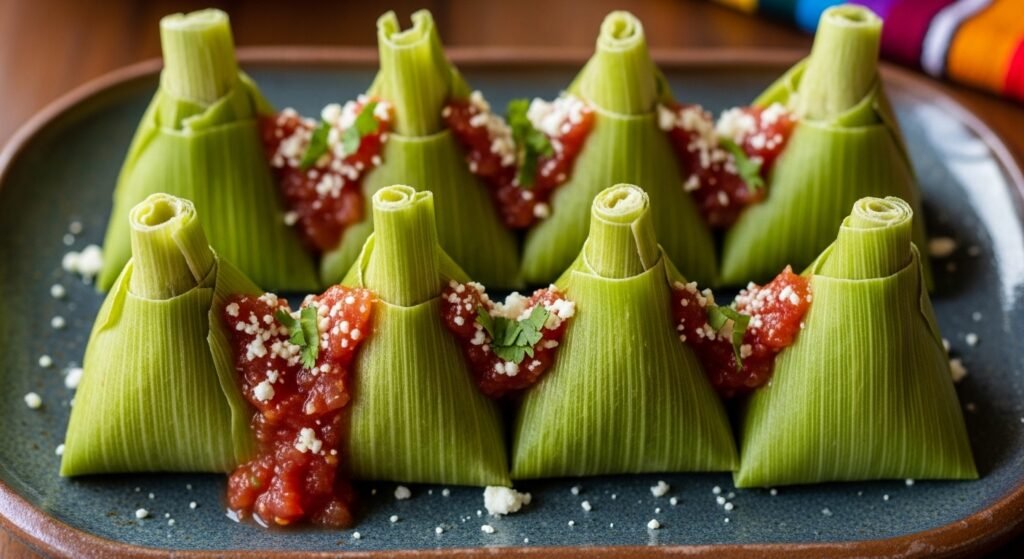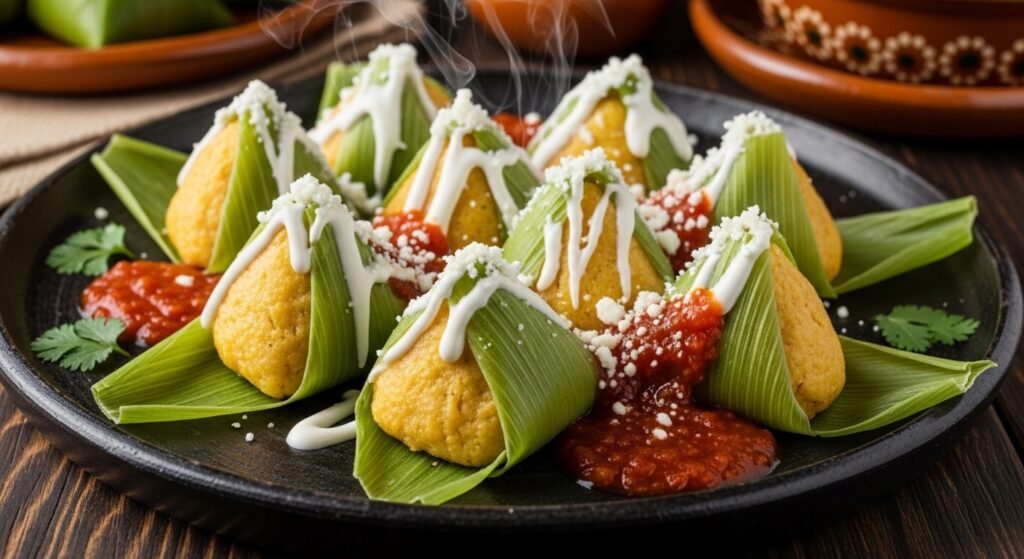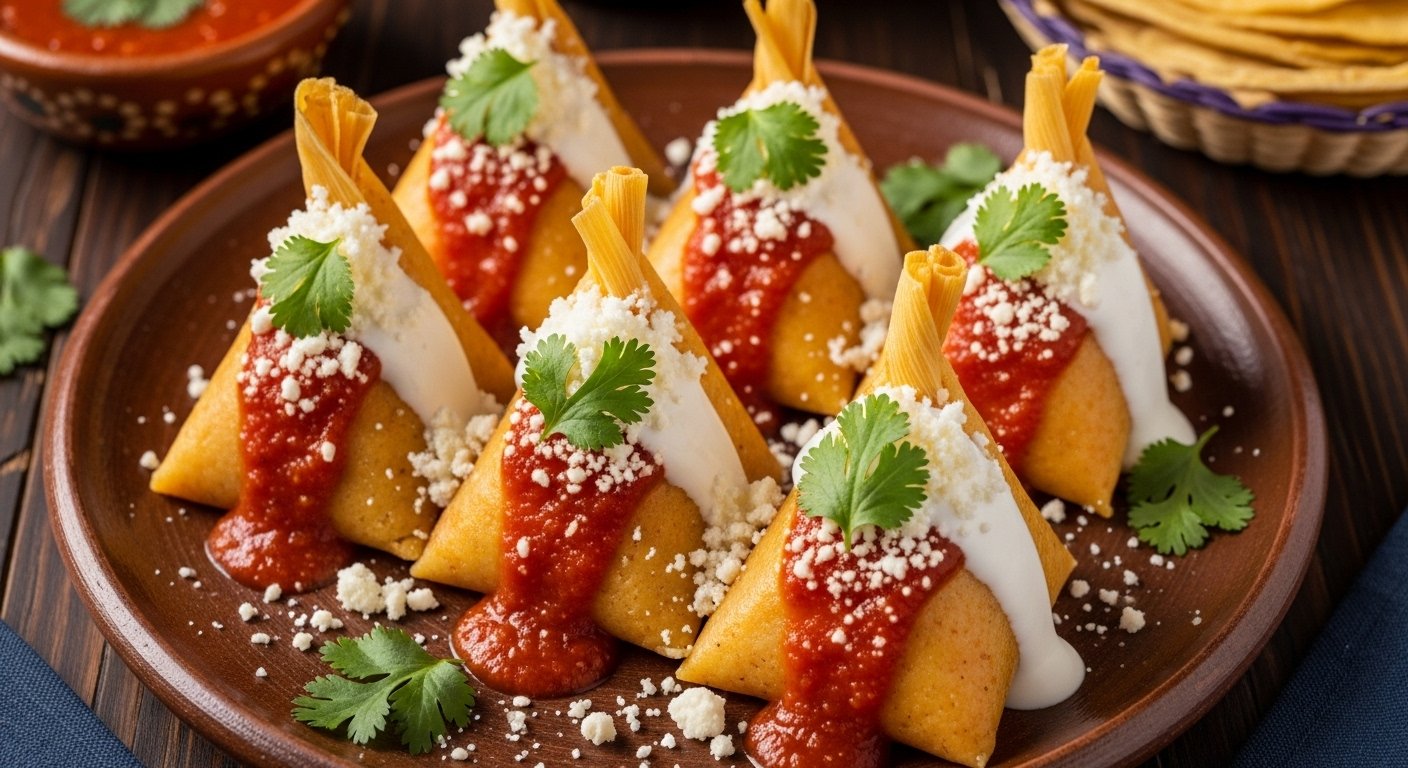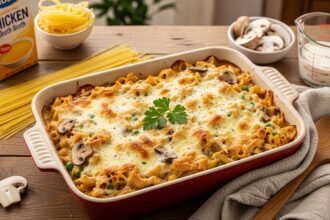Table of Contents
If you’re a fan of authentic Mexican food, you’ve probably heard of tamales. But have you ever tried corundas? These little triangular bundles are a traditional dish from the Mexican state of Michoacán and are often celebrated as a unique and flavorful part of the region’s food culture. While they look similar to tamales at first glance, corundas have their own history, taste, and cooking style that make them truly special. Wrapped in green corn leaves and shaped like cones or triangles, corundas are soft, warm, and comforting—perfect for family dinners or festive gatherings. Whether you’re discovering them for the first time or grew up enjoying them at home, there’s something magical about unwrapping a freshly steamed corunda and digging into its rich, fluffy interior. In this complete guide, you’ll learn everything you need to know about corundas—from their history and ingredients to how they’re made and best enjoyed. We’ll explore different variations, cultural roots, and even offer tips for making them at home. Whether you’re a foodie, a home cook, or someone craving new flavors, this article is a flavorful journey you won’t want to miss. Let’s unwrap the warm and wonderful world of corundas.
What Are Corundas?
Corundas are a type of traditional Mexican tamal, but with a few key differences. They come from Michoacán, a state in western Mexico known for its rich food traditions. Unlike regular tamales that are wrapped in corn husks and often filled with meat or cheese, corundas are usually wrapped in fresh green corn leaves and don’t always have fillings. Their shape also stands out—they’re often made into triangles or cones, which gives them a unique look. They’re typically served as a side dish or with flavorful toppings like red salsa, sour cream, or cheese. The dough, or masa, is soft and slightly salty, making every bite a tasty and comforting experience.
History and Origins of Corundas
The history of corundas dates back to pre-Hispanic times. They were first made by the Purépecha people, an Indigenous group in the Michoacán area. Corundas were often prepared for special ceremonies or to offer to guests as a sign of respect. Their shape and ingredients were symbolic, using corn, which was seen as a sacred food. Over time, corundas became a staple in everyday meals and celebrations. Today, they are still a beloved dish during festivals, family gatherings, or holiday feasts in Michoacán and surrounding areas. The tradition continues, and each family may have its own secret recipe passed down through generations.
How Corundas Are Different from Tamales
At first glance, corundas may look like tamales, but they are quite different. Tamales are usually filled with meats, sauces, or cheeses, while corundas are typically made with plain, seasoned masa. The texture of corundas is softer and moister compared to most tamales. Another major difference is in the wrapping. Tamales are wrapped in dry corn husks, but corundas use fresh green corn leaves, which add a different flavor and aroma. Also, while tamales are generally rectangular, corundas are cone- or triangle-shaped. They’re often served with toppings instead of fillings, giving people the option to dress them up however they like.
Ingredients Needed to Make Corundas
Making corundas at home doesn’t require many ingredients, but what you use—and how you use it—matters a lot. The main ingredient is masa, which is corn dough made from corn flour (masa harina) and water or broth. You also need lard or vegetable shortening to give the dough a fluffy texture. Baking powder and salt are added for flavor and softness. The wrapping is done using fresh green corn leaves, sometimes from young corn plants. While traditional corundas are often plain, some recipes may include cheese, vegetables, or chiles. If you’re planning to add toppings, keep sour cream, salsa, or crumbled cheese on hand.
How to Shape and Wrap Corundas

One of the most exciting parts about preparing corundas is shaping and wrapping them. Once your masa is ready, you take a scoop and place it in a long green corn leaf. Then, fold and twist the leaf carefully to make a triangle or cone shape. It may take a little practice, but once you get the hang of it, it becomes a fun part of the process. You can secure the shape by folding the ends neatly or tying them with a thin strip of corn leaf. The wrapping helps keep the corunda together during steaming while giving it that special earthy flavor from the fresh leaves.
Cooking Corundas: The Steaming Process
After wrapping your corundas, the next step is cooking them through steaming. Place the corundas upright in a large steamer (tamale steamer or “tamaleras” work great), making sure they are packed closely to help them keep their shape. Fill the steamer with water below the rack and cover with a tight lid. Steam the corundas for about an hour to an hour and a half. You’ll know they’re ready when the masa is firm and no longer sticks to the leaves. Be careful when removing them from the steamer because they’ll be very hot. After a few minutes of cooling, they’re ready to serve and enjoy.
Popular Toppings and Side Dishes
While corundas usually aren’t filled, the magic comes in the toppings. One classic way to serve them is with a generous spoonful of red salsa or green tomatillo sauce. A dollop of sour cream adds smooth, cool contrast to the warm masa. Crumbled cotija cheese or queso fresco is a common finishing touch. Some people also enjoy their corundas with a side of beans, grilled meats, or even eggs. You can make them part of a full meal or let them shine on their own with a few simple toppings. Either way, they’re comforting, tasty, and open to your imagination.
Variations of Corundas Across Mexico
While corundas are most famous in Michoacán, you’ll find a few fun variations in other parts of Mexico. Some people make sweet corundas by adding sugar and cinnamon to the masa. Others will include chopped jalapeños, diced onion, or cheese mixed right into the corn dough. In certain areas, larger versions called “uchepos” are made with fresh corn kernels and are a little sweeter, softer, and often eaten during corn harvest season. Though similar, uchepos and corundas are clearly different in feel and taste. Every household might have its own way of making this dish, which keeps the tradition alive and always evolving.
How to Enjoy Corundas at Celebrations
In Michoacán and other parts of Mexico, corundas often play a big role during holidays, religious festivals, and family celebrations. They’re popular at Las Posadas during Christmas, Día de la Candelaria in February, and even weddings or birthdays. Because they’re easy to prepare in large batches, families will spend the day making dozens of them together. It’s a time of bonding, laughter, and working side by side. At gatherings, a basket full of warm corundas is usually served with bowls of salsa and cheese for guests to add as they wish. If you’re lucky enough to attend a corunda-filled celebration, be sure to grab one when they’re warm and fresh!
Nutritional Info: Are Corundas Healthy?
Corundas can be part of a healthy diet, depending on how they’re prepared and what you eat with them. On their own, they’re made mostly from masa (corn) and steam-cooked, which means they’re lower in fat compared to fried foods. The lard or shortening can add some fat, but you could use a lighter oil if you prefer. Add veggies or reduce the toppings to lower calories even more. If you’re adding heavy cheese and sour cream, be mindful of portion sizes. Corundas offer fiber from corn masa, and if paired with beans or lean protein, they can make a balanced meal.
How to Store and Reheat Leftover Corundas
If you have leftover corundas, don’t worry—they store well and reheat nicely. Place them in an airtight container once they’ve cooled. You can store them in the refrigerator for up to three days. When you’re ready to enjoy them again, steam them for about 10–15 minutes until warmed through. Avoid microwaving corundas in plastic wrap, especially with the corn leaf still on. If you’re planning to freeze them, wrap each one tightly in foil and place them in a zip-top freezer bag. They can be frozen for up to two months. Re-steam without defrosting for about 20–25 minutes for best results.
Tips for First-Time Corunda Makers

If it’s your first time making corundas, take your time with the wrapping process. It might seem tricky at first, but it’s easy once you get used to folding the leaves into triangle shapes. Try making a few practice versions before steaming your main batch. Use soft, well-hydrated masa to make shaping easier. If the dough is too dry, your corundas might crack. Prepare all your ingredients ahead of time so everything’s ready for assembly. Invite friends or family to join in—it’s more fun together and helps you make more in less time. Finally, don’t worry if they don’t look perfect—homemade is about flavor and love, not perfection.
Corundas and Mexican Identity
Corundas are more than just food—they’re a symbol of local pride in Michoacán and among people of Purépecha heritage. They represent the strength of Indigenous ingredients and cooking techniques passed down through centuries. When someone makes corundas, they are continuing a living tradition that honors both family and culture. For many, they’re a connection to home, to parents or grandparents, and to land. In today’s fast-paced world, taking time to make and eat corundas reminds us to slow down, honor our history, and enjoy the tasty gifts that come from our roots.
FAQs
1. Are corundas the same as tamales?
No. Corundas are similar to tamales but smaller, cone-shaped, and often without fillings.
2. What are corundas wrapped in?
They are wrapped in green corn leaves, which add a special flavor and help hold their shape.
3. Can I freeze corundas?
Yes. Wrap them tightly and freeze for up to two months. Reheat by steaming.
4. Do corundas always come with toppings?
Not always. Some people enjoy them plain, but many add salsa, cheese, or sour cream.
5. Can I make corundas without lard?
Yes. You can swap lard for vegetable oil or shortening to make a lighter version.
6. Are corundas vegetarian-friendly?
Absolutely. Traditional corundas have no meat, but it’s best to check or make them yourself to be sure.
Final Thoughts
If you love discovering authentic, flavorful tradition, then corundas offer a perfect taste of Mexican culture. With their soft masa, warm wrapping, and rich history, corundas bring more than just a meal—they bring a story. Whether you try them at a local market or make them with your own two hands, you’ll experience something special. These triangle-shaped treasures remind us that great food comes from simple ingredients, care, and time. So the next time you’re craving real comfort food or exploring traditional recipes, say yes to corundas. You’ll enjoy not just the flavor, but the culture they come from.






